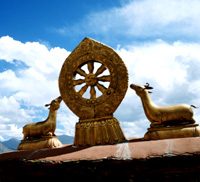Bhakti Yoga
God’s Fire of Love
 “In their heart love is blooming in every moment. Every one of their gestures expresses devotion. Everything they do is an offering to God. They are the Bhakti Yogis – the followers of the path of endless love and frenetic aspiration towards the Absolute Divine.”
“In their heart love is blooming in every moment. Every one of their gestures expresses devotion. Everything they do is an offering to God. They are the Bhakti Yogis – the followers of the path of endless love and frenetic aspiration towards the Absolute Divine.”
The word BHAKTI denotes man’s overwhelming and mysterious love for God, impregnated with respect and adoration. Bhakti Yoga, the devotion path, is one of the most elevated methods that permit the accomplishing of the state of communion with the Absolute Divine. The path of intense love for God is characterized by the extrodinary impetus of love and of the pure spontaneity in the act of adoration.
The total and overwhelming love for God, the shortest and the most energetic way to reach Him, permits recognizing the Supreme Divine Centre (the self) as the Whole, the essential place of endless love and of the immortal peace. With the mind focused in an unique radiant point (Atman), the true bhakti penetrates all illusory appearances which were covering for him this Centre and thus, instantly will issue forth the fire of love, which will burn the artificial and limited circle that was previously separating the great yogi from his profound inner as well as from the fundamental cosmic totality ( God).
Bhakti is the
thread which unites the heart of the disciple with the heart of God. It is the continuous outpouring of love before the Adored One, in a real divine “infatuation”.
The condition or attitude of the yogi who feels for God a sincere, total and unconditional love is called Bhava. The Bhakti tradition mentions five different types of manifestation of love:
1. In Shanta Bhava, the disciple is characterized by a permanent attitude of peace and piety. His heart is pervaded by the love before God and for all beings, regarded as His manifestation. The simple thought to Him awakens in the adept’s being an overwhelming joy.
2. In Dasya Bhava, the disciple permanently lives a state of abandoning his will before the will of God. His entire devotion is offered to the Divine or Spiritual Master, from all his heart. Through everything he does, he seeks to please Him, and thus he finds his joy and comfort.
 3. In Sakhya Bhava, God is seen as being the best friend. Before the best friend we show ourselves as we are, we do not hide anything, our soul is open and we can communicate in the intimacy of our being with God himself. This kind of relationship existed between Arjuna and Krishna,
3. In Sakhya Bhava, God is seen as being the best friend. Before the best friend we show ourselves as we are, we do not hide anything, our soul is open and we can communicate in the intimacy of our being with God himself. This kind of relationship existed between Arjuna and Krishna,
4. In Vatsalya Bhava, the disciple regards God as his child, taking care of Him, serving Him, nourishing Him, as a mother takes care of her son. Yosoda was such a disciple for Krishna.
5. The last and the highest form of Bhava is Madhurya Bhava or Kanta Bhava, characterized through the approach that God is considered as the lover. This Bhava leads rapidly, in case of a sincere and frenetic love, to the communion with God. Thus, the one who loves and the one to be loved become one heart, keeping though this separation to feel and to enjoy the bliss of the cosmic game between them. This was the relationship between Radha and Krishna.
The state of devotion before God can be amplified in nine different ways, which are characterized though by a common element: intense and overwhelming love before Him. In the treaties of oriental wisdom, Srimad-Bhagavad and Vishnu-Purana mentions the following nine aspects of Bhakti:
1. Sravana – to study divine truths, teachings
2. Kirtana – to sing hymns of glory dedicated to the Divine
3. Smarana – to remember constantly of the name and presence of God
4. Padasevana – to serve God
5. Archana – to adore God
6. Vandana – to pray to God
7. Dasya – to amplify the state of devotion before the Divine
8. Sakhya – to amplify the state of friendship with God
9. Atmanivedana – to abandon completely before the Supreme Divine Will.
The follower of the devotion path can choose any bhakti method which suits him the best. Following this path with perseverance, he will finally attain divine illumination.
 1. Saravana presumes careful studying of the divinely inspired stories about the virtues and glory of God, about His name and His form, also, under the direction of an authentic spiritual master to apply what he understands from the sacred texts. The authentic spiritual master can offer to his disciple who listens with an open heart, the correct understanding of the spiritual truths and the way to put them into practice.
1. Saravana presumes careful studying of the divinely inspired stories about the virtues and glory of God, about His name and His form, also, under the direction of an authentic spiritual master to apply what he understands from the sacred texts. The authentic spiritual master can offer to his disciple who listens with an open heart, the correct understanding of the spiritual truths and the way to put them into practice.
2. Kirtana means to devote hymns of glory to God. Overwhelmed constantly by the ecstasy of the divine love, the follower sings and dances all around, adoring God. Just by hearing the name of his Most Loved one, the heart of the disciple is filled with overwhelming and frenetic love, expressed through hymns of love.
3. Smarana means remembering endlessly of God. The yogi is permanently aware of the divine presence in everything surrounding him. In every being, in everything surrounding him, he sees first the glorious manifestation of the divine. Frequently, this disciple talks about God and meditates on His attributes.
4. Padasevana means serving the whole humanity seeing it like a manifestation of the Divine. For this yogi, granting support and help for others means to participate full of love to the divine creation, and thus being in harmony with all universal laws.
5. Archana means the adoration of God. This adoration can have as a starting point an inspired representation, certain sacred hymns, or even a state of overwhelming love which appears spontaneously. The meditations of adoration and gratitude, of imperious and unhindered ardor toward God can lead the disciple’s being to supreme state of ecstasy, Samadhi.
6. Vandana is prayer full of humbleness and aspiration, pronounced with a sincere heart, full of love. Divine Grace is flows over the disciple, reaching finally the state of Godliness.
7. Dasya Bhakti is characterized by a total state of devotion and abnegation. This state is attained through meditation on the divine attributes, on the nature and mystery of the divine, as well as through sharing these revelations with others.
8. Sakhya Bhakti means amplifying the feeling of friendship with God. To be always with Him, to consider Him the best Friend, to be in His presence permanently, to love Him like a best Friend – this is Sakhya Bhakti.
9. Atma Nivedana means to offer to God our whole being, considering everything happening to us as gifts offered by God, gifts from which we have something to learn. This disciple gives up to his own limited will and abandons himself to the Will of God. He became thus a channel of manifestation of the divine energy, which purifies and elevates his whole being, leading him to the supreme realization.
 The nine aspects of Bhakti are ways through which the follower of the devotional path can attain the supreme ideal of life: communion with God. For Jesus, God was the Heavenly Father. Ramakrishna adored Him in his aspect of Divine Mother.
The nine aspects of Bhakti are ways through which the follower of the devotional path can attain the supreme ideal of life: communion with God. For Jesus, God was the Heavenly Father. Ramakrishna adored Him in his aspect of Divine Mother.
Many others have attained perfection through the adoration of Jesus. Many others have attained perfection adoring Krishna as a lover. Let’s remember every moment that God is there inside us, He is the closest and most beloved one to us. As we become more aware of the divine omnipresence, so we will be closer to the attaining the supreme goal.
Yogaesoteric
February 2007


